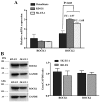Prognostic value and functional role of ROCK2 in pediatric Ewing sarcoma
- PMID: 29434937
- PMCID: PMC5777092
- DOI: 10.3892/ol.2017.7571
Prognostic value and functional role of ROCK2 in pediatric Ewing sarcoma
Abstract
Ewing's sarcoma (EWS) is a highly aggressive bone cancer that affects children and adolescents. Despite advances in multimodal management, 5-year event-free survival rates for patients presenting with metastases at diagnosis remain at 25%. As key regulators of actin organization, the Rho-associated coiled-coil containing protein kinases, ROCK1 and ROCK2, have been associated with cancer dissemination and poorer prognosis. Recently, in vitro data indicating ROCK2 as a molecular target for the treatment of EWS has been presented. Nonetheless, a deeper exploration of the contribution of this kinase dysregulation in EWS is still necessary. In this regard, the present study aimed to evaluate the expression of ROCK1 and ROCK2 in 23 pediatric tumor samples and to verify the prospect of using their pharmacological inhibition through functional assays. Our results showed positive immunostaining for ROCK1 and ROCK2 in the majority samples (75 and 65%, respectively). A significantly increased risk of incomplete remission in patients with positive immunostaining for ROCK2 was found (P=0.026), though no correlations with other prognostic features (huvos classification, FLI1/EWS status, relapse, metastasis or death) were observed. Associations with survival were merely suggestive. Apparent protein expression of both kinases was also found in EWS cell lines (SK-ES-1 and RD-ES). Treatments with selective ROCK inhibitors did not alter cell viability or migration in vitro. However, a significant increase in invasion was observed after treatment with SR3677 (ROCK2 inhibitor) and hydroxyfasudil (pan-inhibitor). Consequently, even though the majority of EWS samples included in our study showed positivity for ROCK1 and ROCK2, the lack of significant associations with prognosis and absence of appropriate responses to their inhibition in vitro does not support their prospective use as therapeutic targets for the treatment of this metastatic tumor. Larger cohort studies might provide more evidence on whether there is a specific role of ROCK kinases in EWS physiopathology.
Keywords: Ewing sarcoma; ROCK; expression; inhibition; target.
Figures




References
LinkOut - more resources
Full Text Sources
Other Literature Sources
Research Materials
Miscellaneous
